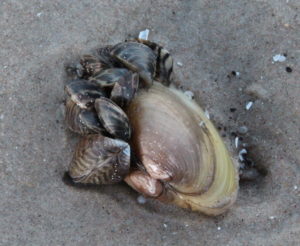
The aquatic invasive species zebra mussels are now in the RM of St. Clements in the Red River (confirmed in 2015) and Lake Winnipeg (confirmed in 2013). As of 2017, they have not yet been found in Gull Lake.
Zebra mussels are spread to new waters largely by contaminated boats and water-related equipment. Once zebra mussels become established they cannot removed, so it is extremely important to stop their spread.
How to Stop the Spread of Zebra Mussels
Adult zebra mussels have a hard shell and attach to anything that sits in the water. This includes boats, canoes, trailers, float planes, buoys, fishing equipment, etc. They can survive out of water for 7 to 30 days depending on temperature and humidity.
Larval zebra mussels, called veligers, passively move downstream by water movement and are invisible to the naked eye. Veligers rely on water to survive thus they can be carried in small amounts of water transported by un-drained watercraft, water-based aircraft, off road vehicles and water-based equipment such as bait buckets.
It is crucial to always clean, drain and dry your watercraft, trailer, float plane and all water-related equipment when leaving a lake or river. Drain or empty any standing water away from storm sewers, lakes and rivers. Dispose of any unwanted bait in the trash, not in the water.
For more details on how to stop the spread of aquatic invasive species go to the Manitoba Government’s website at www.gov.mb.ca/stopthespread/ais/how.html
Why do we need to be concerned about zebra mussels and other aquatic invasive species?
Zebra mussels are a highly adaptable, non-native species that are a significant environmental and economic concern to Manitoba.
- They disrupt ecosystems by eating food that other species rely on and changing the quality of the water
- They can attach to and smother other mussels
- A general rule is 90% of the native mussel population will die within ten years of zebra mussel arrival
- They attach to boats and motors reducing performance and efficiency
- The sharp shells attach to rocks, rafts and ladders and can cut swimmers feet
- They can clog intake and drainage pipes
Zebra mussels have caused millions of dollars in damage to the Laurentian Great Lakes area and have cost the North American economy billions of dollars to control. They were first found in North America in 1988 in Lake St. Clair which straddles the US and Canadian border in Michigan and Ontario.
What are Invasive Species?
Organisms (animals, plants, parasites, viruses etc) not native to a region that when introduced, either intentionally or accidentally, out-compete native species for available resources. Invasive species become successful in their new environments due to their high reproductive rates and absence of native predators and diseases. Invasive species can have negative economic, social, environmental and human health implications.
What are Aquatic Invasive Species (AIS)?
An aquatic invasive species (AIS) can either live in freshwater or marine environments. Most of the species of concern to Manitoba, such as Zebra and Quagga mussels, Spiny Waterflea, Rusty Crayfish and Asian Carp are freshwater species. Manitoba currently has 15 aquatic invasive species. This number is small compared to the number of aquatic invasive species found in the Great Lakes (greater than 200) and Mississippi (greater than 120) drainage basins.
What are zebra mussels?
Zebra mussels are small, finger-nail sized (1 – 3 cm), clam-like freshwater aquatic animals native to Eastern Europe and Western Asia. they are D-shaped with dark and light brown stripes. Unlike other mollusks, they have hair-like filaments called byssal threads that they use to attach themselves to hard surfaces including other mussels. They are highly adaptable. The female lays about one million eggs per year. Their lifespan is 2-5 years.
Can you eat zebra mussels?
Zebra mussels are small and do not have much in the way of “meat” inside them. Because they are filter feeders, they can accumulate pollutants in their tissues that may not be healthy for people to consume.
Zebra Mussels in Manitoba
Zebra mussels were confirmed in Lake Winnipeg in the fall of 2013 and the Red River and Cedar Lake 2015.
In May of 2014, the provincial government closed four harbours (Balsam Bay, Winnipeg Beach, Gimli and Arnes) and treated them with liquid potash, which is harmless to humans but lethal to zebra mussels. This successfully killed the zebra mussels in the treated areas but Zebra mussels were elsewhere in the south basin of Lake Winnipeg and are successfully reproducing.
Lake Winnipeg is in the early stages of invasion by zebra mussels – eradication is no longer an option. There is no technology available to eliminate them from a lake the size of Lake Winnipeg at this time. For Lake Winnipeg, the only option is to monitor and adapt to the effects of zebra mussels and prevent them from being established in other bodies of water.
In November 2015 the Manitoba government passed legislation making it illegal to transport aquatic invasive species, aquatic plants or mud on water-related equipment.
Resources
- http://www.gov.mb.ca/sd/waterstewardship/stopais/
- The Riding Mountain UNESCO World Biosphere Reserve (RMBR) has developed an ‘Online information kit’ that includes key links to Manitoba aquatic invasive species information sources posted by other jurisdictions, which are also striving to stop the spread at Spread the Word, Not the Mussels Information Kit
- https://www.lakewinnipegfoundation.org/zebra-mussels-101
